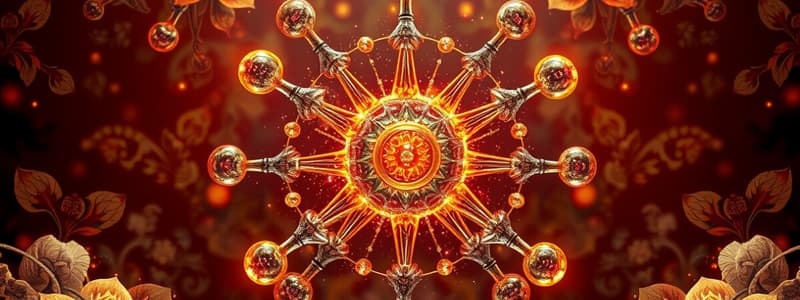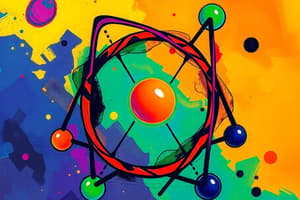Podcast
Questions and Answers
What is the main purpose of elements bonding with each other?
What is the main purpose of elements bonding with each other?
- To increase molecular weight
- To achieve stability (correct)
- To create electrical charges
- To form ionic bonds only
According to the octet rule, how many electrons can be present in the outer orbital of an atom at maximum?
According to the octet rule, how many electrons can be present in the outer orbital of an atom at maximum?
- 10
- 6
- 8 (correct)
- 2
Which type of bond is formed by a pair of shared electrons?
Which type of bond is formed by a pair of shared electrons?
- Hydrogen bond
- Metallic bond
- Ionic bond
- Covalent bond (correct)
What is the ratio of carbon to hydrogen to oxygen in all carbohydrate molecules?
What is the ratio of carbon to hydrogen to oxygen in all carbohydrate molecules?
What is the monomer structure of carbohydrates called?
What is the monomer structure of carbohydrates called?
Which of the following is NOT a common example of a carbohydrate?
Which of the following is NOT a common example of a carbohydrate?
Which of the following lipids contains no monomers?
Which of the following lipids contains no monomers?
What structural function do carbohydrates serve in plants?
What structural function do carbohydrates serve in plants?
What is the primary function of lipids?
What is the primary function of lipids?
Which of the following describes the structure of proteins?
Which of the following describes the structure of proteins?
What is NOT a common example of a lipid?
What is NOT a common example of a lipid?
What elements are found in nucleic acids?
What elements are found in nucleic acids?
Which type of fat is typically found in fish?
Which type of fat is typically found in fish?
Which is a function of proteins?
Which is a function of proteins?
What makes up the backbone of DNA?
What makes up the backbone of DNA?
Which of the following components are crucial in forming an amino acid?
Which of the following components are crucial in forming an amino acid?
Flashcards are hidden until you start studying
Study Notes
Atom Bonding and Electrons
- Elements bond to achieve stability through electron sharing or transfer.
- Neutral atoms and positively charged atoms are located in the nucleus, while negatively charged electrons orbit around it.
- Electrons follow the octet rule, filling electron shells in the pattern of 2, 8, 8.
- Valence electrons, like 8e in the outer shell, are crucial for chemical bonding.
- A shared pair of electrons forms a covalent bond.
The Big 4 Biomolecules
Carbohydrates
- Composed of carbon, hydrogen, and oxygen with a ratio of 1:2:1.
- Serve primarily for short-term energy storage.
- Monomer: Monosaccharides (simple sugars) like glucose (C6H12O6).
- Polymers consist of long chains of glucose; hexagonal structures indicate glucose.
- Classic examples include starch in plants and glycogen in animals.
- Structural roles: Cellulose (cell walls) and chitin (exoskeletons).
Lipids
- Made up of carbon, hydrogen, and oxygen, but not in a 1:2:1 ratio.
- Do not have monomers; built from a glycerol backbone and up to three fatty acid tails.
- Known for long-term energy storage, providing 9 calories per gram (versus carbohydrates at 4 calories per gram).
- Functions include insulation, protection, energy storage, nutrient absorption, and hormone production.
- Main components of cell membranes.
- Common examples: Fats (saturated and unsaturated), oils, phospholipids, waxes, blubber, and steroids.
Proteins
- Composed of carbon, hydrogen, oxygen, nitrogen, and sulfur (CHONS).
- Monomers are amino acids, characterized by an amino group (NH2) and a carboxyl group (COOH).
- Proteins are polymers known as polypeptides.
- Functions of proteins include:
- Enzymes that regulate chemical reactions.
- Antibodies that support the immune system.
- Structural roles in cells, muscles, and fibers (e.g., hair and nails).
Nucleic Acids
- Contain carbon, hydrogen, oxygen, nitrogen, and phosphorus (CHONP).
- Monomers: Nucleotides, which include a sugar, phosphate group, and nitrogenous base.
- Polymers include DNA (deoxyribonucleic acid) and RNA (ribonucleic acid).
- Functions:
- DNA serves as hereditary material and is fundamental for genetics.
- RNA is crucial for protein synthesis.
Studying That Suits You
Use AI to generate personalized quizzes and flashcards to suit your learning preferences.




